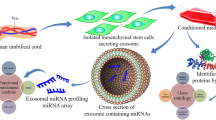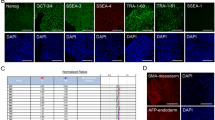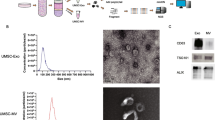Abstract
Background
Umbilical cord mesenchymal stem cells (UCMSC) are subsets of multipotent stem cells involved in immune modulation, tissue regeneration, and antimicrobial defense. Cellular senescence is associated with the onset of aging-related diseases and small extracellular vesicles (sEVs) are important mediators of senescence and aging.
Objective
However, little is known about the role and function of microRNAs (miRNAs) carried by UCMSC-derived sEVs. To analyze the expression profiles of miRNAs secreted by senescent UCMSC, small RNA sequencing of the miRNAs within the sEVs was performed in this study.
Methods
UCMSC cultures underwent serial passaging beyond passage number 20 to achieve replicative senescence, which was confirmed by various methods, including increased senescence-associated β-gal staining and cytokine secretion levels. sEVs derived from non-senescent and senescent UCMSC were isolated and characterized by nanoparticle tracking analysis, transmission electron microscopy, and immunoblot analysis.
Results
Small RNA sequencing of the miRNAs within the sEVs revealed senescence-associated differences in the miRNA composition, as shown by the upregulation of miR-122-5p and miR-146a-5p, and downregulation of miR-125b-5p and miR-29-3p. In addition, total RNA sequencing analysis showed that PENK, ITGA8, and TSIX were upregulated, whereas AKR1B10, UNC13D, and IL21R were downregulated by replicative senescence in UCMSC. In sEVs, upregulated genes were linked to downregulated miRNAs, and vice versa. In the gene-concept network analysis, five gynecologic terms were retrieved.
Conclusions
The study provides an insight into the cellular characteristics of UCMSC following replicative senescence and emphasizes the importance of monitoring passage numbers of UCMSC for further therapeutic use.






Similar content being viewed by others
References
Aurich H, Sgodda M, Kaltwasser P, Vetter M, Weise A, Liehr T, Brulport M, Hengstler JG, Dollinger MM, Fleig WE et al (2009) Hepatocyte differentiation of mesenchymal stem cells from human adipose tissue in vitro promotes hepatic integration in vivo. Gut 58:570–581
Basisty N, Kale A, Jeon OH, Kuehnemann C, Payne T, Rao C, Holtz A, Shah S, Sharma V, Ferrucci L et al (2020) A proteomic atlas of senescence-associated secretomes for aging biomarker development. PLoS Biol 18:e3000599
Bojanic C, To K, Zhang B, Mak C, Khan WS (2020) Human umbilical cord derived mesenchymal stem cells in peripheral nerve regeneration. World J Stem Cells 12:288–302
Chandravanshi B, Bhonde RR (2018) Human umbilical cord-derived stem cells: isolation, characterization, differentiation, and application in treating diabetes. Crit Rev Biomed Eng 46:399–412
Chen K, Wang D, Du WT, Han ZB, Ren H, Chi Y, Yang SG, Zhu D, Bayard F, Han ZC (2010) Human umbilical cord mesenchymal stem cells hUC-MSCs exert immunosuppressive activities through a PGE2-dependent mechanism. Clin Immunol 135:448–458
Coppe JP, Desprez PY, Krtolica A, Campisi J (2010) The senescence-associated secretory phenotype: the dark side of tumor suppression. Annu Rev Pathol 5:99–118
Dimarino AM, Caplan AI, Bonfield TL (2013) Mesenchymal stem cells in tissue repair. Front Immunol 4:201
Faruqu FN, Liam-Or R, Zhou S, Nip R, Al-Jamal KT (2021) Defined serum-free three-dimensional culture of umbilical cord-derived mesenchymal stem cells yields exosomes that promote fibroblast proliferation and migration in vitro. FASEB J 35:e21206
Ghannam S, Bouffi C, Djouad F, Jorgensen C, Noël D (2010) Immunosuppression by mesenchymal stem cells: mechanisms and clinical applications. Stem Cell Res Ther 1:2
Gorgoulis V, Adams PD, Alimonti A, Bennett DC, Bischof O, Bishop C, Campisi J, Collado M, Evangelou K, Ferbeyre G et al (2019) Cellular senescence: defining a path forward. Cell 179:813–827
Hayflick L, Moorhead PS (1961) The serial cultivation of human diploid cell strains. Exp Cell Res 25:585–621
Jeppesen DK, Fenix AM, Franklin JL, Higginbotham JN, Zhang Q, Zimmerman LJ, Liebler DC, Ping J, Liu Q, Evans RJC (2019) Reassessment of exosome composition. Cell 177:428-445.e418
Kanehisa M, Furumichi M, Tanabe M, Sato Y, Morishima K (2017) KEGG: new perspectives on genomes, pathways, diseases and drugs. Nucleic Acids Res 45:D353–D361
Kim JA, Seong RK, Shin OS (2016) Enhanced viral replication by cellular replicative senescence. Immune Netw 16:286–295
Krasnodembskaya A, Song Y, Fang X, Gupta N, Serikov V, Lee J-W, Matthay MA (2010) Antibacterial effect of human mesenchymal stem cells is mediated in part from secretion of the antimicrobial peptide LL-37. Stem Cells 28:2229–2238
Kumari R, Jat P (2021) Mechanisms of cellular senescence: cell cycle arrest and senescence associated secretory phenotype. Front Cell Dev Biol 9:485
Lee JK, Oh S-J, Gim J-A, Shin OS (2022) miR-10a, miR-30c, and miR-451a encapsulated in small extracellular vesicles are pro-senescence factors in human dermal fibroblasts. J Investig Dermatol 2022:S0022-202X(22)00363–3
Leng Z, Zhu R, Hou W, Feng Y, Yang Y, Han Q, Shan G, Meng F, Du D, Wang S et al (2020) Transplantation of ACE2(-) mesenchymal stem cells improves the outcome of patients with COVID-19 pneumonia. Aging Dis 11:216–228
Li T, Yan Y, Wang B, Qian H, Zhang X, Shen L, Wang M, Zhou Y, Zhu W, Li W et al (2013) Exosomes derived from human umbilical cord mesenchymal stem cells alleviate liver fibrosis. Stem Cells Dev 22:845–854
Li X, Liu L, Yang J, Yu Y, Chai J, Wang L, Ma L, Yin H (2016) Exosome derived from human umbilical cord mesenchymal stem cell mediates MiR-181c attenuating burn-induced excessive inflammation. EBioMedicine 8:72–82
Liu S, Mahairaki V, Bai H, Ding Z, Li J, Witwer KW, Cheng L (2019) Highly purified human extracellular vesicles produced by stem cells alleviate aging cellular phenotypes of senescent human cells. Stem Cells 37:779–790
Liu SJ, Meng MY, Han S, Gao H, Zhao YY, Yang Y, Lin ZY, Yang LR, Zhu K, Han R et al (2021) Umbilical cord mesenchymal stem cell-derived exosomes ameliorate HaCaT cell photo-aging. Rejuvenation Res 24:283–293
Marino L, Castaldi MA, Rosamilio R, Ragni E, Vitolo R, Fulgione C, Castaldi SG, Serio B, Bianco R, Guida M et al (2019) Mesenchymal stem cells from the Wharton’s jelly of the human umbilical cord: biological properties and therapeutic potential. Int J Stem Cells 12:218–226
Mensà E, Guescini M, Giuliani A, Bacalini MG, Ramini D, Corleone G, Ferracin M, Fulgenzi G, Graciotti L, Prattichizzo F (2020) Small extracellular vesicles deliver miR-21 and miR-217 as pro-senescence effectors to endothelial cells. J Extracell Vesicles 9:1725285
Monguio-Tortajada M, Roura S, Galvez-Monton C, Pujal JM, Aran G, Sanjurjo L, Franquesa M, Sarrias MR, Bayes-Genis A, Borras FE (2017) Nanosized UCMSC-derived extracellular vesicles but not conditioned medium exclusively inhibit the inflammatory response of stimulated T cells: implications for nanomedicine. Theranostics 7:270–284
Oh M, Lee J, Kim YJ, Rhee WJ, Park JH (2018) Exosomes derived from human induced pluripotent stem cells ameliorate the aging of skin fibroblasts. Int J Mol Sci 19:1715
Oh SJ, Lim S, Song MJ, Ahn JH, Lee CH, Shin OS (2019) Whole Transcriptome analyses reveal differential mRNA and microRNA expression profiles in primary human dermal fibroblasts infected with clinical or vaccine strains of varicella Zoster virus. Pathogens 8:183
Oh SJ, Gim JA, Lee JK, Park H, Shin OS (2020) Coxsackievirus B3 infection of human neural progenitor cells results in distinct expression patterns of innate immune genes. Viruses 12:325
Oh SJ, Lim BK, Yun J, Shin OS (2021) CVB3-mediated mitophagy plays an important role in viral replication via abrogation of interferon pathways. Front Cell Infect Microbiol 11:704494
Olivieri F, Lazzarini R, Recchioni R, Marcheselli F, Rippo MR, Di Nuzzo S, Albertini MC, Graciotti L, Babini L, Mariotti S et al (2013) MiR-146a as marker of senescence-associated pro-inflammatory status in cells involved in vascular remodelling. Age 35:1157–1172
Park SJ, Kumar M, Kwon HI, Seong RK, Han K, Song JM, Kim CJ, Choi YK, Shin OS (2015) Dynamic changes in host gene expression associated with H5N8 avian influenza virus infection in mice. Sci Rep 5:16512
Pittenger MF, Discher DE, Peault BM, Phinney DG, Hare JM, Caplan AI (2019) Mesenchymal stem cell perspective: cell biology to clinical progress. NPJ Regen Med 4:22
Scheers I, Lombard C, Paganelli M, Campard D, Najimi M, Gala JL, Decottignies A, Sokal E (2013) Human umbilical cord matrix stem cells maintain multilineage differentiation abilities and do not transform during long-term culture. PLoS ONE 8:e71374
Seong RK, Lee JK, Cho GJ, Kumar M, Shin OS (2020) mRNA and miRNA profiling of Zika virus-infected human umbilical cord mesenchymal stem cells identifies miR-142-5p as an antiviral factor. Emerg Microbes Infect 9:2061–2075
Terlecki-Zaniewicz L, Lämmermann I, Latreille J, Bobbili MR, Pils V, Schosserer M, Weinmüllner R, Dellago H, Skalicky S, Pum DJA (2018) Small extracellular vesicles and their miRNA cargo are anti-apoptotic members of the senescence-associated secretory phenotype. Aging 10:1103
Thery C, Witwer KW, Aikawa E, Alcaraz MJ, Anderson JD, Andriantsitohaina R, Antoniou A, Arab T, Archer F, Atkin-Smith GK et al (2018) Minimal information for studies of extracellular vesicles 2018 (MISEV2018): a position statement of the International Society for Extracellular Vesicles and update of the MISEV2014 guidelines. J Extracell Vesicles 7:1535750
Tipnis S, Viswanathan C, Majumdar AS (2010) Immunosuppressive properties of human umbilical cord-derived mesenchymal stem cells: role of B7–H1 and IDO. Immunol Cell Biol 88:795–806
Tokar T, Pastrello C, Rossos AE, Abovsky M, Hauschild A-C, Tsay M, Lu R, Jurisica I (2018) mirDIP 4.1—integrative database of human microRNA target predictions. Nucleic Acids Res 46:D360–D370
Weilner S, Schraml E, Redl H, Grillari-Voglauer R, Grillari J (2013) Secretion of microvesicular miRNAs in cellular and organismal aging. Exp Gerontol 48:626–633
Weiss ML, Anderson C, Medicetty S, Seshareddy KB, Weiss RJ, VanderWerff I, Troyer D, McIntosh KR (2008) Immune properties of human umbilical cord Wharton’s jelly-derived cells. Stem Cells 26:2865–2874
Xu D, Tahara H (2013) The role of exosomes and microRNAs in senescence and aging. Adv Drug Deliv Rev 65:368–375
Acknowledgements
This research was funded by MD-PhD/Medical Scientist Training Program through the Korea Health Industry Development Institute (KHIDI), funded by the Ministry of Health & Welfare, Republic of Korea, and the Basic Science Research Program of the National Research Foundation of Korea (NRF) by the Ministry of Science, ICT & Future Planning (NRF-2019R1A2C1005961). This research was also funded by the Basic Science Research Program through NRF by the Ministry of Education (NRF-2020R1I1A1A01052701).
Author information
Authors and Affiliations
Corresponding authors
Ethics declarations
Conflict of interest
CGK, JKL, G-JC, OSS, and J-AG declare that they have no conflict of interest.
Additional information
Publisher's Note
Springer Nature remains neutral with regard to jurisdictional claims in published maps and institutional affiliations.
Supplementary Information
Below is the link to the electronic supplementary material.
Rights and permissions
Springer Nature or its licensor holds exclusive rights to this article under a publishing agreement with the author(s) or other rightsholder(s); author self-archiving of the accepted manuscript version of this article is solely governed by the terms of such publishing agreement and applicable law.
About this article
Cite this article
Kim, C.G., Lee, J.K., Cho, GJ. et al. Small RNA sequencing of small extracellular vesicles secreted by umbilical cord mesenchymal stem cells following replicative senescence. Genes Genom 45, 347–358 (2023). https://doi.org/10.1007/s13258-022-01297-y
Received:
Accepted:
Published:
Issue Date:
DOI: https://doi.org/10.1007/s13258-022-01297-y




